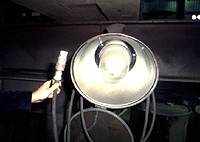
|
|
|
Text version of flowchart: |
|
|
| Emergency/Auxiliary Standby Generator |
|
|
| | |
| |
|
| |
|
| |
|
Shore Power
Switch Boards |
|
| | |
| |
________ |
|
|
| |
| Ship's Main Switch Boards |
|
| | |
|
|
|
|
______ |
|
______ |
|
|
|
|
|
| | |
| |
| |
|
|
|
| Equipment, Lighting, etc. |
|
| Note: Typically all levels may be fed by more
than one source. |
|
|
There are two sources of electrical power used during
building and repair of a vessel -- shore side and vessel generated. (See diagram).
The potential for electrical shock hazards is greater
in shipbuilding and repair than in other industries, because workers stand on metal
decks and often work in a wet environment. Work on or around
energized electrical equipment can expose workers to electrocution,
burns, or electrical shock. Before work is performed, energized equipment
must be guarded, deenergized, or appropriate PPE used to prevent worker
exposure. [1915.181,
1915.157(c)]
Note: 1910 Subpart S: Electrical and the
National Electric Code (NFPA 70) do not apply to the vessel's electrical
system.
Use of portable electrical tools and lighting can
also be found in the following modules:
For shipbuilding:
For ship repair:
Note: Confined space entry is one of the leading
hazards associated with barge cleaning. Review the
Ship Repair: Confined/Enclosed Spaces and Other Dangerous Atmospheres
chapter for information on how to protect workers from this hazard.
|
Electrical
Circuits and Distribution Boards |
Electrical circuit and distribution board
standard [1915.181] applies to the vessel's permanently installed
electrical circuits and distribution systems. Temporarily installed
electrical systems (such as extension cords, portable service panel,
"spider box") used for repairing of the vessel is
covered in the Tools [1915.132] and General Working Conditions
[1915.92 and
1915.93(b)] modules.
Potential Hazards:
-
Worker
electrical shock, burns, or electrocution due to contact with or near to energized
electrical equipment.
-
Falls from
elevations.
Requirements and Example Solutions:
-
Before work is performed on circuits, except
those
being tested or adjusted, circuits must be deenergized and checked at
the point where work will be performed to ensure the circuits are
actually deenergized. [1915.181(b)]
-
When testing or adjusting energized circuits, a
rubber or other suitable insulated deck mat must be used. [1915.181(b)]
-
Deenergizing the circuit must be appropriately completed by
opening the circuit breaker, opening the switch, or removing the fuse.
[1915.181(c)]
-
The circuit breaker, switch, or fuse
location must be tagged to indicate work is occurring on
the circuit. Such tags must not be removed nor the circuit energized
until the work has
been completed. [1915.181(c)]
-
When work is performed immediately adjacent to exposed
energized parts, these parts must be covered (for example, insulated) or other equally safe means
provided. [1915.181(d)]
Note: Control of Hazardous Energy Sources (Lockout/Tagout)
standard [1910.147]
does not apply to Ship Repair.
|

Figure 1: Improper practice: Faulty breaker box presents shock hazard.

Figure 2: Portable distribution panel used to supply temporary electrical power.

Figure 3: Circuit breakers in panel box can be used to deenergize circuits (and appropriately tagged) before working on the circuit.
|
|
|
Maritime
Labor/Industry Recommendations |
- Insulating materials (such as mats and gloves) should be periodically
tested or inspected.
- All electrical tools or equipment should undergo a visual inspection
before use.
- All portable electric hand tools and temporary lighting systems
should utilize Ground Fault Circuit Interrupters (GFCI).
- Electrical tools and equipment should correspond with the
requirements of the job.
- Electrical equipment and tools should be used with proper circuit
protection for the voltage and amperage used.
- Only qualified electricians should attempt repair of electrical
tools and equipment in use.
- A Ground Assurance Program should be in place for all electrical
tools and equipment used including:
- Records of tools inspected and repaired.
- Records of electrical boxes inspected and repaired.
- Records of electrical extension cords inspected and repaired.
- Recall of records of the above.
- The requirements of the Ground Assurance Program should be performed
on a regular basis.
|

Figure 4: Inspection of explosion proof light electrical connector.

Figure 5: Temporary lights connected to ground fault circuit interrupter.

Figure 6: Electrical tools and equipment must be turned in for repair by a qualified electrician. |
 Back
to Top
Back
to Top |
|

